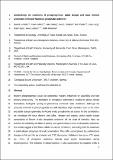Files in this item
Constraining the conditions of phosphogenesis : stable isotope and trace element systematics of Recent Namibian phosphatic sediments
Item metadata
| dc.contributor.author | Lumiste, Kaarel | |
| dc.contributor.author | Mänd, Kaarel | |
| dc.contributor.author | Bailey, Jake | |
| dc.contributor.author | Stüeken, Eva E. | |
| dc.contributor.author | Paiste, Kärt | |
| dc.contributor.author | Lang, Liisa | |
| dc.contributor.author | Sepp, Holar | |
| dc.contributor.author | Lepland, Aivo | |
| dc.contributor.author | Kirsimäe, Kalle | |
| dc.date.accessioned | 2022-03-30T23:46:36Z | |
| dc.date.available | 2022-03-30T23:46:36Z | |
| dc.date.issued | 2021-03-31 | |
| dc.identifier | 273686004 | |
| dc.identifier | 6b9ebc96-30a9-443a-aa44-b6882505ad63 | |
| dc.identifier | 85104295785 | |
| dc.identifier | 000645903700008 | |
| dc.identifier.citation | Lumiste , K , Mänd , K , Bailey , J , Stüeken , E E , Paiste , K , Lang , L , Sepp , H , Lepland , A & Kirsimäe , K 2021 , ' Constraining the conditions of phosphogenesis : stable isotope and trace element systematics of Recent Namibian phosphatic sediments ' , Geochimica et Cosmochimica Acta , vol. In Press . https://doi.org/10.1016/j.gca.2021.03.022 | en |
| dc.identifier.issn | 0016-7037 | |
| dc.identifier.other | Jisc: b330cde7773e435ea6950da2a31191d3 | |
| dc.identifier.other | ORCID: /0000-0001-6861-2490/work/92020167 | |
| dc.identifier.uri | https://hdl.handle.net/10023/25127 | |
| dc.description | This study was supported by the Estonian Science Agency project PRG447 and the Estonian Centre of Analytical Chemistry. K. Paiste was supported by the European Union’s Horizon 2020 research and innovation program under the Marie Skłodowska-Curie grant agreement No 894831. We would also like to thank the organizers and participants of the Regional Graduate Network in Oceanography Discovery Camp 2015, funded by the Agouron Institute and the Scientific Committee for Oceanographic Research (SCOR), as well as the Namibian Ministry of Fisheries and Marine Resources and the captain and crew of R/V Mirabilis for access to the coring site. | en |
| dc.description.abstract | Modern phosphogenesis occurs on continental margins influenced by upwelling and high primary productivity. The formation of phosphatic sediments is coupled to global climate fluctuations, biological cycling of phosphorus and local redox conditions. Although the processes involved in phosphogenesis are well described, high-resolution data on the redox and stable isotope systematics in Recent in-situ phosphorites are scarce. In this contribution, we investigate the trace element and sulfur, nitrogen and organic carbon stable isotope composition of Recent in-situ phosphatic sediments off the coast of Namibia. Also, we examine the reliability of different widely used geochemical proxies in phosphatic sediments. Our results suggest a shift from sulfidic to suboxic conditions, coinciding with the maximum in solid calcium phosphate mineral concentration. This shift is accompanied by unidirectional changes in Mo and Re enrichments and TOC abundance. Relatively low pyrite δ34S values (ca -20‰) of phosphatic sediments indicate open system fractionation during phosphogenesis. The initiation of phosphogenesis is also accompanied by negative shifts in sedimentary δ13Corg and δ15N values. Phosphate associated sulfate (PAS) δ34S values are lower than modern seawater sulfate values, suggesting the involvement of chemolithotrophic sulfur oxidation. Our results show a shift in redox conditions from sulfidic to (sub)oxic, coupled with active sulfur cycling are prerequisites for phosphogenesis. Phosphatic sediments show substantial enrichments in U and V highlighting the complexity of using these elements, as well as V/(V+Ni) and V/Cr, as redox proxies particularly in phosphorites and phosphatic sediments. | |
| dc.format.extent | 1381627 | |
| dc.format.extent | 161020 | |
| dc.language.iso | eng | |
| dc.relation.ispartof | Geochimica et Cosmochimica Acta | en |
| dc.subject | QD Chemistry | en |
| dc.subject | QE Geology | en |
| dc.subject | NDAS | en |
| dc.subject | SDG 13 - Climate Action | en |
| dc.subject.lcc | QD | en |
| dc.subject.lcc | QE | en |
| dc.title | Constraining the conditions of phosphogenesis : stable isotope and trace element systematics of Recent Namibian phosphatic sediments | en |
| dc.type | Journal article | en |
| dc.contributor.institution | University of St Andrews. School of Earth & Environmental Sciences | en |
| dc.contributor.institution | University of St Andrews. St Andrews Centre for Exoplanet Science | en |
| dc.identifier.doi | 10.1016/j.gca.2021.03.022 | |
| dc.description.status | Peer reviewed | en |
| dc.date.embargoedUntil | 2022-03-31 |
This item appears in the following Collection(s)
Items in the St Andrews Research Repository are protected by copyright, with all rights reserved, unless otherwise indicated.


